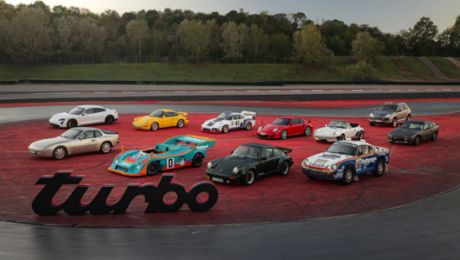The birthday present was unique, a one-off. The birthday girl can be considered a unique individual, too. Ferry Porsche gave his sister Louise Piëch a special prototype from the development center in Weissach for her 70th birthday on August 29, 1974: the 911 Turbo “No. 1” – the first 911 for the road with a turbocharger, a technical highlight.
It didn’t yet feature a style-defining attribute of the later production model: the mighty fender extensions. The first 911 Turbo wore a slimline dress. The rear deck lid did, however, already feature the protruding wing with an all-round rubber lip, which was later christened the whale tail. The centerpiece was the supercharged 2.7‑liter engine with power of 177 kW (240 PS). The production version of the 930 – its official type number – boasted 3.0 liters and 191 kW (260 PS), and was the fastest German series production vehicle at the time.
Photos of the birthday party by the Wörthersee lake show that Louise Piëch was delighted with this exquisite gift. Her enthusiasm for sports cars – including their corresponding driving style – is legendary. “I like to drive fast, and I enjoy it, too,” she once admitted. “She didn’t like to have anyone in front of her,” remembers her eldest son Ernst, “she wasn’t keen on being second.”
First child of Aloisia and Ferdinand Porsche
This is hardly surprising considering the family she was born into. Louise was born in Vienna in 1904 as the first child of Aloisia and Ferdinand Porsche. Her brother Ferdinand, called Ferry, followed five years later in 1909. At the time, her father was already a well-known automotive design engineer at Austro-Daimler. He loved fast and light cars, and enjoyed competing in races in them himself.
With great success. In 1910, for example, he won the renowned Prinz-Heinrich-Fahrt race around Germany over a distance of almost 2,000 kilometers. His daughter was sitting beside him during the lap of honor. The Austro-Daimler AD 35 “Louise Wagen” of 1914 was named after her. She was given one of these open-top touring cars as a 16th birthday present. She was already a seasoned driver by then. “Everything revolved around cars in our grandfather’s house,” explains Ernst Piëch, “and she was fascinated by them, too.”
When her father Ferdinand joined Daimler-Motoren-Gesellschaft in Stuttgart, the name Louise Porsche even cropped up in motorsport. Driving the Mercedes supercharged car, she went up against established competitors, among others, in the Süddeutsche Tourenfahrt and AvD-Kartellfahrt events in 1927. The plucky amateur also took a stab at the local hill climb – at a time when a “lady behind the wheel” (special-interest magazine Motor und Sport, 1927) was considered something rather exotic. The fashion-conscious sport driver’s contemporary accessory of choice was the beret.
Spiritual balance in painting
But speed wasn’t everything for young Louise Porsche. She intensified her passion for painting by studying in Vienna. Watercolor landscapes were her preferred motif. She drew peace and strength from her art, and she continued to paint into old age. “She was never bored and led an active and eventful life from childhood on,” her youngest son Hans Michel reminisces. “She found spiritual balance in her painting.”
Louise’s career as an amateur race car driver came to an end in 1928 when she married the Viennese attorney Anton Piëch, who went on to be his father-in-law’s most important legal adviser. The young couple remained in Vienna and set up home on the Küniglberg hill in the Hietzing district, not far from the magnificent Schönbrunn Palace. Their son Ernst was born in 1929, followed by Louise (1932), Ferdinand (1937), and Hans Michel (1942). “Even as a married woman, she maintained a very strong relationship with her father,” says Ernst Piëch. “They got along very well, and she therefore always knew what was going on in Stuttgart.”
Louise Piëch never limited herself to the traditional role of housewife. She was a mother of four, a talented painter, and an enthusiastic huntswoman. And like her brother Ferry, she was involved in her father’s activities early on. Especially after Ferdinand Porsche founded his design office together with Anton Piëch and Adolf Rosenberger in 1931 to take on development contracts with a committed team. “From an early age, she wanted to play a part in preserving what my grandfather had built up,” explains Hans Michel Piëch. “She saw this as a generational task early on.”
Looking back herself, Louise Piëch once said: “I was very interested in my father’s work, but I didn’t intend to become a businesswoman.”
But things were not to turn out as she had planned. Her expertise, business acumen, and insight into human nature proved to be a godsend for the company’s new beginning after the Second World War. The design office had been relocated from Stuttgart to Gmünd in the Austrian state of Carinthia in 1944 for safety reasons. “My father chose the location,” she reported later in life, “as he was an Austrian by birth.” In addition, the Schüttgut estate, an old farm in Zell am See some 125 kilometers away, had been the domicile of the Porsche and Piëch family and other relatives since 1941. Toward the end of the war, there were multiple generations all living under one roof. “There was always a lot going on as there were, at times, more than 30 children and adults there,” relates Ernst Piëch, “and my mother managed it with aplomb, as one says.”
“As children, her success story always served as an example to us.” Hans Michel Piëch
In the austere postwar period, Louise Piëch bore the burden of being responsible not only for her own four children, but also for her brother’s four sons as well as for a farm and the design office. Her father, husband, and brother were being held by the French. Together with senior engineer Karl Rabe, she got the business back up and running in the former Gmünd sawmill with the old Porsche team. With some effort, she was able to keep the workshop going with the aid of long-standing employees by taking on small repair jobs and producing winches and small batches of tractors. For the time being, sports cars remained a dream, even after the return of her brother Ferry.
Safeguarding the life’s work of their father
Gmünd was a second plant of the still existing Porsche KG. The siblings Louise and Ferry ventured a further step to safeguard the life’s work of their father and the future of the entrepreneurial family in spring 1947 when they founded the company Porsche Konstruktionen GesmbH in Gmünd. Orders were essential for the company’s survival. Long-standing relationships then came to the aid of 43-year-old Louise: Karl “Carlo” Abarth, the husband of Anton Piëch’s former secretary, whom he had helped flee to Yugoslavia at the outbreak of the war, turned to her. Through Abarth, who had since relocated to Italy, the Porsche and Piëch family came into contact with Piero Dusio.
The affluent industrialist placed an order, among others, for a Grand Prix car for his sports car brand Cisitalia. “A technical gem, one of the most interesting Grand Prix cars in the world,” Louise Piëch was still enthusing years later. The 360 type was never entered into a race, but it did save the fledgling company. “Firstly, with Dusio’s orders, we were able to keep Gmünd busy,” Louise Piëch reminisced later, “and secondly, we were able to arrange the bail money for my father and my husband in France to be released.” When Ferdinand Porsche returned to Austria approaching the age of 72, his son Ferry, who had been released before, showed him the drafts of the 360 type. “I asked him what he thought of our work,” Ferry Porsche once recounted, describing the scene. “My father said ‘I would have approached the task in exactly the same way’ and patted me on the shoulder.” Praise indeed.
Encouraged, Ferry Porsche fulfilled a long-cherished dream. In 1948, the first sports car to bear the name Porsche – the 356 “No. 1” Roadster – was developed on the basis of the Volkswagen. The conclusion of an agreement with Volkswagen proved to be another masterstroke of family cooperation. It included permission for Volkswagen parts to be used in Porsche sports cars, a license fee for every Volkswagen constructed, and the exclusive status as Volkswagen’s general importer for Austria.
Optimistic despite all the setbacks
Starting in 1948, the first rear-engine sports cars of the type 356 were manufactured in Gmünd in small series production under the management of Ferry Porsche. They were presented for the first time by Louise Piëch and Ferry Porsche at the Geneva International Motor Show in 1949. Import operations commenced in Salzburg under the auspices of Louise and Anton Piëch with the importing of the first 14 Volkswagen sedans. A year later, Ferry Porsche moved sports car production to Stuttgart, while Louise and her husband remained in Austria to build up the sales organization. The siblings each held shares in both companies.
The company suffered two strokes of fate during this period of initial recovery – Ferdinand Porsche died on January 30, 1951, aged 75, and only around 18 months later Louise’s husband Anton Piëch died unexpectedly at the age of 57. She was 48 at the time and joined the management of the Salzburg company. “My mother took on this role without hesitation,” says Hans Michel Piëch. “She always took the initiative when this was called for.” This was an expression not only of her understanding of performing one’s duties, but also of her fundamentally positive attitude, he says. Ernst Piëch adds: “She remained optimistic despite all the setbacks.” Her demeanor and responsible manner with employees shaped the corporate culture.
Commercial Councillor
Thanks to the great prudence and commercial intuition of Frau Kommerzialrat (Commercial Councillor), as she was called, Porsche Salzburg evolved into the biggest automobile trading company in Europe over the decades. In a far-reaching decision taken in 1971, Louise Piëch and Ferry Porsche decreed that all family members should withdraw from operational positions in the growing company – both in Salzburg and Stuttgart. Henceforth, the business was only to be run by external managers. Louise Piëch and Ferry Porsche moved to the supervisory bodies. The siblings felt a lifelong connection, also as trusted business partners.
“I would say she was perhaps the more resolute of the two, whereas my uncle was more focused on balance,” says Ernst Piëch, “so they complemented one another very well.” As one of the most successful businesswomen in Austria, Louise Piëch remained the grande dame of Salzburg and a highly respected member of society.
The Turbo “No. 1” she was given for her 70th birthday was by no means her last Porsche. Even at the age of 90, she still liked to get behind the wheel of the sports car that would never have existed without her. “Up until old age, she liked to drive the 911 the most,” says Ernst Piëch, “but by then she knew her limits.”
Louise Piëch died on February 10, 1999, almost a year after her younger brother Ferry. In accordance with family tradition, she, too, was laid to rest in the private chapel at the Schüttgut estate. Living to be 94 years of age, Louise Piëch experienced almost an entire century, and very much shaped the fortunes of the family business through the epochs. “As children, her success story always served as an example to us,” says Hans Michel Piëch.
Info
Text first published in Christophorus Magazine, issue 411.
Author: Thomas Ammann
Photos: Porsche
Copyright: All images, videos and audio files published in this article are subject to copyright. Reproduction in whole or in part is not permitted without the written consent of Dr. Ing. h.c. F. Porsche AG. Please contact newsroom@porsche.com for further information.

